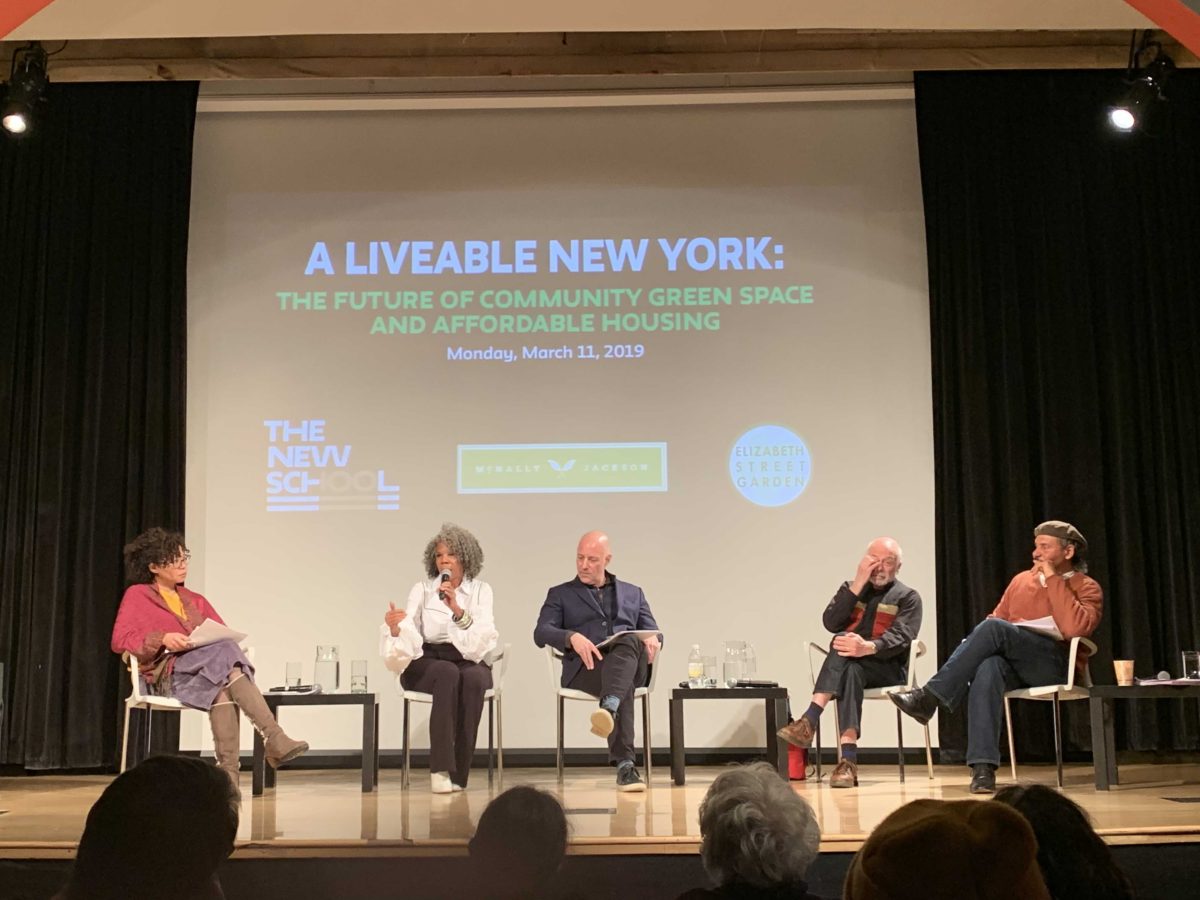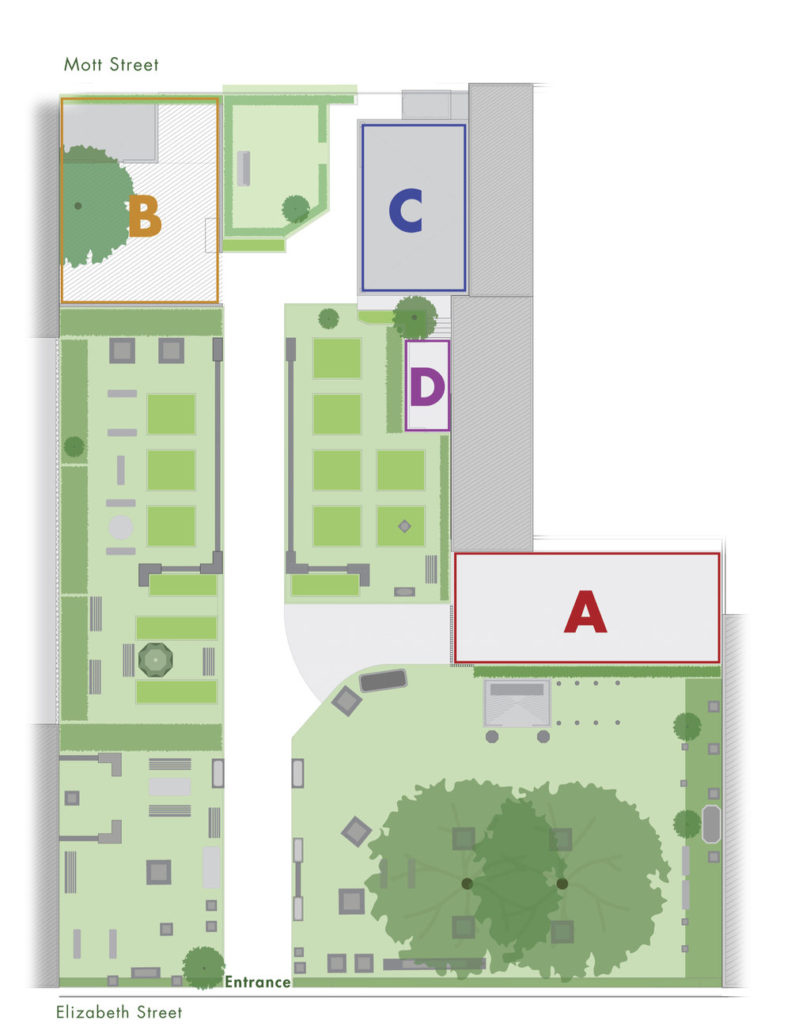
New York might lose one of its most beloved — and scarce — green spaces. The potential closing of Little Italy’s Elizabeth Street Garden, a neighborhood hot spot filled with live music, local art, public programs, and lush green amongst reds, browns and greys, has perpetuated a six-year long battle between the garden and the city of New York.
The New School, Elizabeth Street Garden, and NoLita based book and stationery store McNally Jackson co-hosted a panel debating the garden’s future before spring break on Monday, March 11. Community Board 2, the local community board led by Councilwoman Margaret Chin, have proposed a plan to replace Elizabeth Street Garden with a 123-unit affordable housing development for seniors. This development would take up the entire space of the garden. The ESG and Friends of Elizabeth Street Garden have filed two lawsuits to fight the development and keep the garden.
Mia White, assistant professor of Environmental Studies at Lang, moderated the panel and called for an open and constructive dialogue regardless of various perspectives.
“This is a perennial debate in the context of urban space,” White said. “So I hope nothing we’re pissed about is new. This is an ongoing fight that happens in every part of the world, every city, every state.”
Joseph Revier, the Executive Director of Elizabeth Street Garden, followed with a briefing on the garden’s history and an alternative solution to the city’s housing proposal.
“That’s been the crux of our argument—is that we [ESG] can achieve more affordable housing, and community green space, and preserve Elizabeth Street Garden and not have these entities against each other because they’re both needed in New York,” Revier said.
He showcased blueprint plans for a construction model that incorporates compost space, a greenhouse, a shed and solar panels on a lean-to unit within the space. The plans would maintain the gardens around these units, and create a multi-functioning community space for both greenery and waste management.

The panel featured four native New Yorkers who are dedicated to greenery, displacement, and gentrified communities. This included Alicia Boyd, founder of community displacement organizations Flower Lovers Against Corruption and The Movement To Protect the People, Tom Angotti, professor of Urban Policy and Planning at Hunter College and editor of Zoned Out: Race, Displacement, and City Planning in New York, Charles Birnbaum, President and CEO of The Cultural Landscape Foundation, and Raymond Figueroa, President of the NYC Community Garden Coalition.
Boyd emphasized broader community engagement as a stronger alternative to individual fights against developers and the city’s rezoning and development plans.
“The way that we keep approaching these fights is incorrect. We keep doing individual lawsuits, we keep fighting in our communities, we keep not working with other communities, we keep isolating ourselves in thinking that our particular fight is going to get into war. And that’s not true,” Boyd said. “99% of the time we lose these lawsuits because we’re not working together. We need to be thinking about filing class action lawsuits.”
Boyd also pointed out that racism, bias and white privilege interferes with community cooperation toward filing class action lawsuits around community spaces.
“Why would we allow the city to sell off our land? This is our land, it is our earth, it is our sky, it is our air, and we have a right to it. So let’s think outside the box and removing our prejudices, cause we have our racism, let’s say hey, sit at the table and have a discussion,” Boyd said.
The response from the audience was charged, with passionate cheers, fist pumps and whistles.
Angotti mentioned how the current issue is around community responsibility.
“That’s the crux of the problem we’re facing here,” Angotti said. “The weakness of communities, and the ability of communities to make their own decisions, in a way that’s fair and just. And by just I mean, every community needs to think about its responsibility for the provision and low income, and I mean deeply low income housing,” said Angotti. “But also, everybody has to think about the problems; that we’re running out of open space. What kind of city do we want to live in?”
Raising the question of housing needs while showing support for claiming space, Birnbaum approached the garden debate through the lens of artistic vision and storytelling.
“The municipalities that are doing public reviews should do a determination of eligibility to say, ‘is this a significant feature’? They should do diligence to understand how it contributes to the quality of life and that nothing like this will ever be created ever again. We should cherish it as a place where nature and culture have a great story to tell,” Birnbaum said.
White read a quote from Councilwoman Chin, which stated that there are over 5,000 homeless seniors in her district who are on a waitlist for housing. White then acknowledged that nobody on the panel can identify with or relate to being a senior in desperate need, and that the audience and panel must keep this bias in mind. The discussion then focused on the prospect of failed lawsuits and the garden’s alternatives.
Figueroa explained that city planners have not addressed equity in financial distribution and support of affordable development, thus unfairly analyzing the value of various communities. He also described how the NYC Community Garden Coalition works with regional wide city planners to find new solutions.
“We are actual consultants with the New York City Department of Housing, preservation and development around the development of community land trust, where we’re in negotiation and mutually educated process around how communities can actually own and control the land,” Figueroa said. “We’re taking a regional approach.”
“The only piece missing here is that this is Lenape land,” Angotti said. The Lenape tribe were the indigenous people that owned the territory that is now the five boroughs.
The dialogue on how racism is embedded in urban planning, lower income housing and community garden reform led a two hour conversation that went well into the night.
Talking to the Free Press after the event, White expanded on why students should care about Elizabeth Street Garden, or any community garden in New York.
“When we think about nature, we think about going into the Catskills. We think about going on a hike. And we know we’ve achieved nature as a destination if no one else is there. My pedagogical impulse is that nature is right here in this moment, actually right now. Even in the so called ‘concrete jungle’, there’s nature. In fact, concrete is all natural material,” White said. “So even if nobody cares about the Elizabeth Street Garden, because they’re not gonna ever go there or they just don’t care or they think everyone is crazy, this is emblematic of larger issues, starting with how we understand the environment.”
To support the Elizabeth Street Garden, you can sign their petition, donate, and volunteer.







